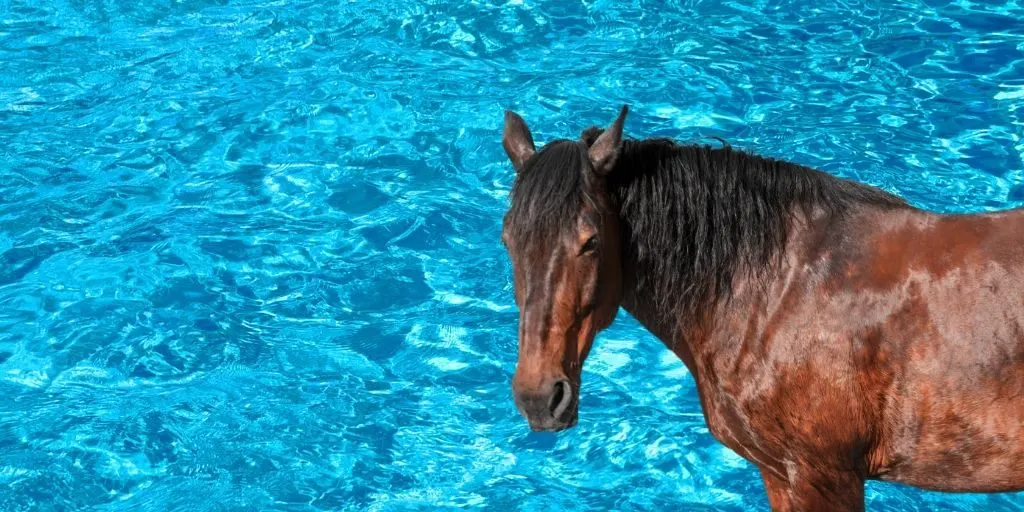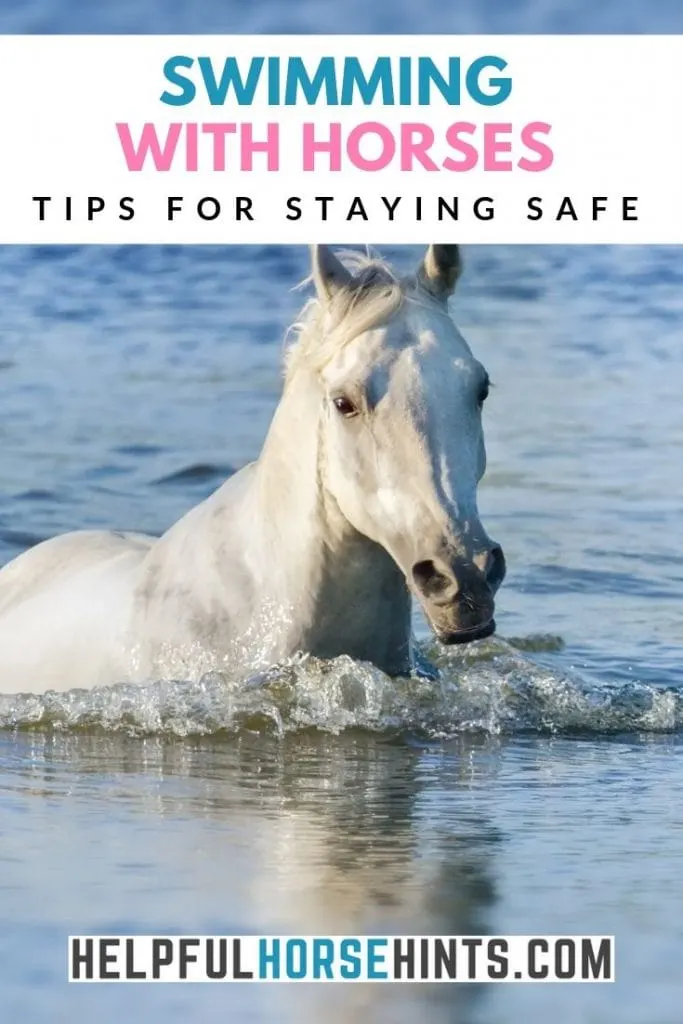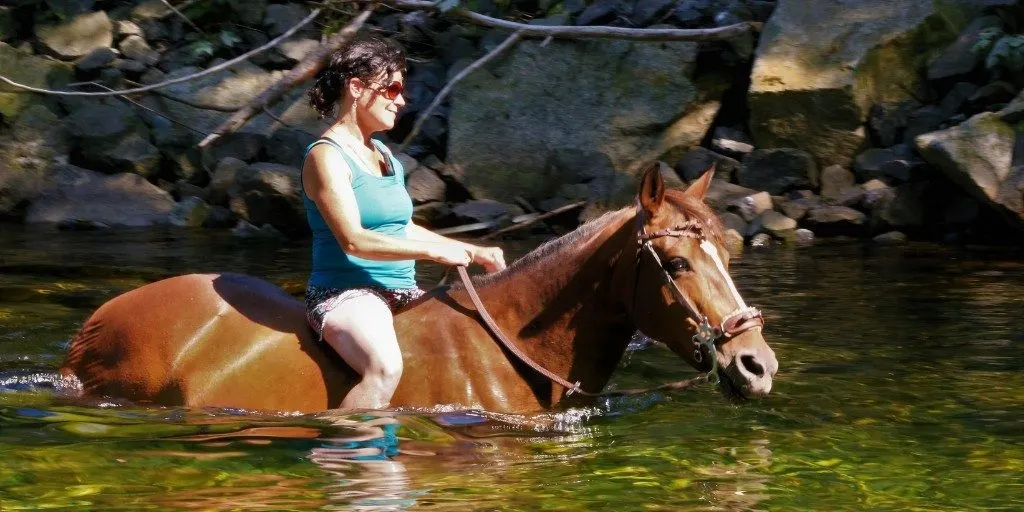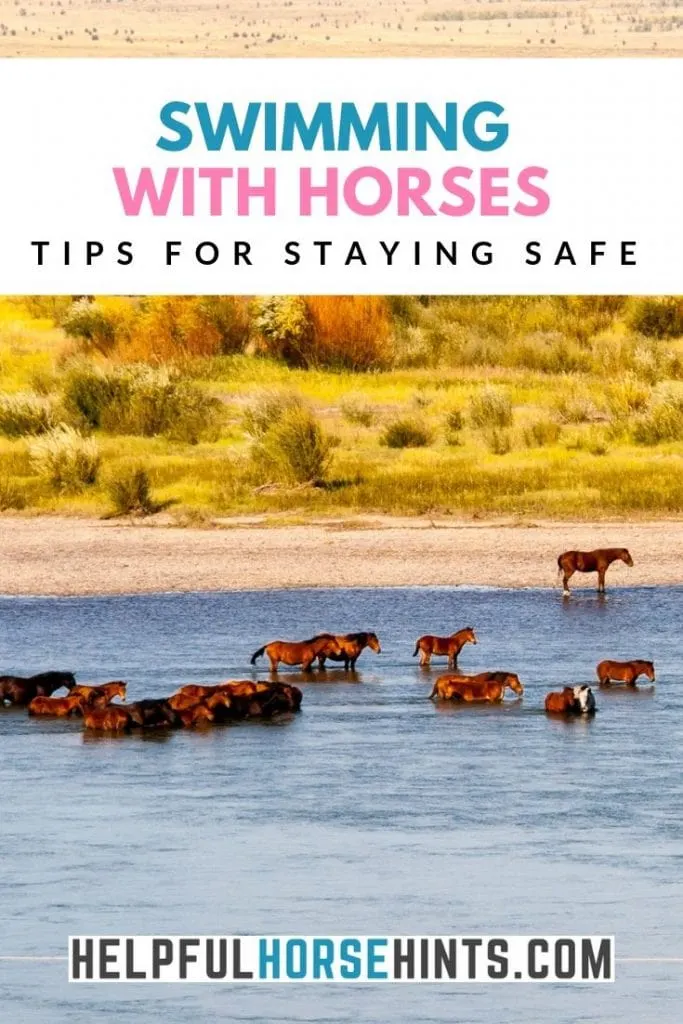Before you take your favorite horse for a swim, you need to be well aware of all the dangers that lurk beyond the surface. Swimming and horses can be an amazing combination, but a good equestrian should know all they can before they embark on a new journey.
Table of Contents
Can Horses Swim?
Adult horses and even young foals can swim and swimming is often used as a rehabilitation method for horses with leg injuries. A number of precautions must be taken to make swimming a safe experience for both the rider and the horse.
Knowledge can prevent dangerous situations when it comes to horses and swimming. Being a responsible horse owner means that you are responsible for keeping your horse out of dangerous situations. Sometimes, that may mean not participating in certain activities.
Yes, some things are beyond our control, but if you do your homework and follow these tips, you can decide whether or not your particular horse should be swimming or not.

Horses and Water
Horses were created with the innate ability to swim. They are able to move through the water by basically trotting underwater and they always keep their heads above the water while they swim.
There is no doubt that a horse is able to swim, the question is whether or not your particular horse is able to do so safely.
There are a number of precautions that need to be taken before you decide if you should go swimming with your horse. It is important to always keep an eye out for potential problems and do your best to remove you and your horse from any distractions as quickly as possible.
The possibility of a horse drowning is a dire truth that you often won’t hear about. If any equestrian has experienced losing a horse to drowning, it is not something that they want to share around the campfire.
It is, however, a truth that you must always keep in the back of your mind. Most of the safety tips provided here are designed to prevent you from experiencing this tragic event.

Considering the Temperament of the Horse and History Around Water
Knowing your horse’s temperament around water is the first step to deciding whether you should take your horse for a swim. Just like there are some people who hate being in the water, there are some horses that just do not like being in the water at all.
For some horses, there is just nothing that you can do to convince them to step one hoof into water. A small puddle may be more than they are willing to walk through, much less swim in a pond or lake.
Horses may even jump tiny creeks just to avoid stepping into the water at all. These horses may never come to enjoy being around water no matter what you do to convince them otherwise.
If you have the time and resources available to you, there are some training facilities that specifically teach horses to swim and possibly even enjoy the water.
If your horse doesn’t seem to be fearful of the water but you are unsure whether they would enjoy swimming, you can always slowly introduce your horse to various bodies of water and gauge its response.
Start with small puddles and creeks to see if your horse has any issues with them. If they are okay with smaller pools of water, you can progress to areas that are larger.
However, if you find that they do not like getting into deeper water, you should definitely not force them go for a swim.
Health Concerns and Benefits
Pros of Taking Your Horse Swimming
On a more positive note, swimming can be extremely beneficial for the health of your horse. It is known as a form of physical therapy for your equine friend.
Just as it does for humans, the water relieves the pressure on joints allowing a horse with joint-related ailments such as arthritis to exercise safely without causing pain.
Swimming can allow your horse to build muscles and stamina without overworking them. There are some facilities that have pools specifically designed for horses that keep them in a controlled and contained environment.
Veterinarians will use them to rehabilitate horses with various leg-related injuries.
In fact, many elite horse training facilities have horse swimming interspersed with normal exercise to work different muscles for the horse and maintain aerobic fitness without providing stress to bones and soft tissue.
Cons of Taking Your Horse Swimming
Horses can encounter various health issues while swimming and exhaustion is one of them. As a precaution, it is also safer to limit their total swim time to 30 minutes or less. This will prevent them from experiencing exhaustion while they are swimming.
Horses also have the ability to experience severe panic during swimming. For example, a jumping fish, a loud boat, or another horse acting out can all cause a horse to panic in the water.
Horses can get so scared that they get away from you and swim too fast in the wrong direction. If they get beyond your reach, they could get so far out that they possibly drown from exhaustion and respiratory distress.
A horse could also hit their legs on rocks or other hazardous materials that are not visible above water. This could cause panic or severe injury to the horse.
It is imperative to be familiar with the swimming locations that you take your horse. Never take them into a body of water that you do not know anything about.

Precautions Before Taking Your Horse Swimming
While it may seem like common sense to some, you should always use a limited amount of tack on your horse if you decide to go swimming with them.
Saddles and pads should be removed before getting in the water. For one, you don’t want to ruin your expensive saddle and you also want to remove any items that can irritate or spook your horse while they are in the water.
For some, this may seem counter-intuitive, but it is actually safer to swim without a saddle than with one. It will be easier to push yourself away from your horse if you are not getting all caught up in the saddle.
Swimming your horse bareback can also keep your horse safe from getting hung up on rocks or low-lying branches.
If you have to leave the saddle on, it is crucial to remove any type of tie-down that keeps your horse from having complete control of its head. A tie-down secures the horse’s head to the girth of the saddle.
Remember, a horse has to be able to keep its head above the water. Anything that impedes that, can cause them to drown. You will, however, always want to keep a bridle or halter and lead rope on them so that you can steer them while in the water.
It is also a safe practice to never go swimming, or even riding, completely alone with your horse. Always take someone with you in case of an accident or emergency. Riding and swimming horses can be the most enjoyable experience of your life, but it can also be dangerous if done alone.

Horse-Friendly Places To Swim
Finding a location to swim that is horse-friendly may not be the easiest task. The simplest way to find the best places are to ask your equestrian friends. They will tell you the good and bad aspects of various swimming holes that are horse-friendly. They also might have creeks or ponds on their own property that they don’t mind you swimming in with your horse.
Many trails that allow horseback riding also will have creeks and small ponds that you can take your horse through. Again, always be cautious about swimming areas that you are unfamiliar with.
Even though horses may be allowed there, it doesn’t necessarily mean that it is safe. If possible, you may want to get in alone first to test the water depth and floor before you take your horse in.
If you can’t find a local lake or pond to take your horse, there are a number of horse-friendly beaches that won’t mind. Be sure to check out local regulations on any seasonal or time restrictions that may apply.
In the end, deciding whether or not you should take your horse swimming depends entirely on your specific horse and the location. Not every horse is equipped to handle swimming and not every swimming area is designed for horses.
If swimming is not a safe option for you and your horse, there are plenty of other activities that will be enjoyable for each of you.
Frequently Asked Questions
Can all horses swim?
Swimming is a natural ability for horses and even young foals can swim without being taught. In the wild, horses will typically learn to swim for the first time by following their herd across water if necessary.
Do horses like to swim?
Some horses really enjoy all things water. They like to splash in it, roll in it, and even swim in it. This love for water varies though from horse to horse.
It is perfectly normal to find a spectrum of love for water among horses. Some love it, some don’t care either way and some would rather avoid it.
If you introduce your horse to the water slowly, most horses will learn to accept swimming on occasion.
Can you ride a horse while it swims?
You can ride a horse while it swims but you should only do so for horses who are experienced with swimming.
If you have never swam your horse before, it is typically safer to let them learn how to swim on a long lunge line without a rider. This will help to keep both the horse and rider safe.
If a horse learns how to swim without a rider they can learn how to move their legs, turn, and navigate the water without having to worry about the extra complication of interference from the rider.
Are horses afraid of water?
Horses don’t see the way we do. A horse’s vision limits its ability to ascertain how deep water is. This can lead to a fear of water.
When teaching your horse how to swim, it is best to always ensure the horse has a gradual slope to use to enter and exit the water.
While we might enjoy jumping off the side of a pool into deep water, big depth changes like that are scary to a horse and can cause them to develop a fear of water.
If you enjoyed this article, you may find these other articles interesting:
- 26 Fun Groundwork Exercises You Can Do With Your Horse
- Summer Bucket List for You and Your Horse
- Signs Your Horse is Afraid


